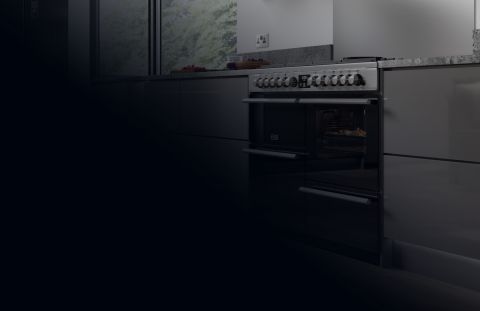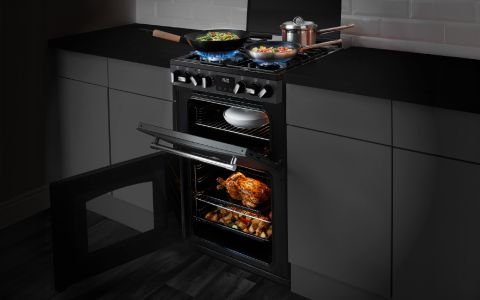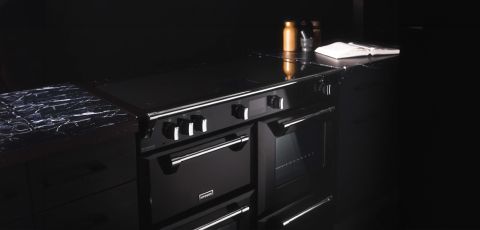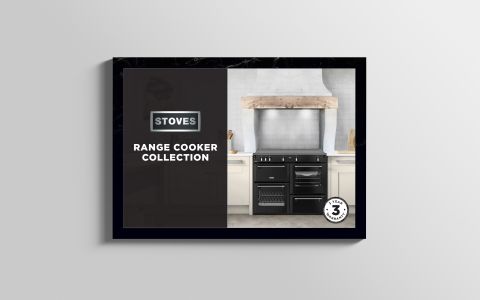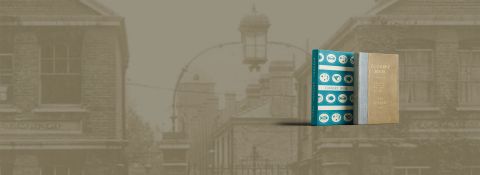
This is our story.
From a small company in the heart of northern England
to one of the largest manufacturers in Europe. This is the
story behind the history and heritage of Stoves.
Origins.
February 14th 1920 - They say that the way to a person's heart is through their stomach, so perhaps that's why Stoves was formed on Valentines Day.
Originally a manufacturer of sheet metal and gas heaters, the owners recognised that a revolution was happening in British kitchens and a growing interest in the art of cookery.
Originally a manufacturer of sheet metal and gas heaters, the owners recognised that a revolution was happening in British kitchens and a growing interest in the art of cookery. h2
Laying down roots.
Stoves relocated from Warrington to its current manufacturing facility in Rainhill, Prescot in 1925.
A former World War I munitions site, the new larger premises allowed Stoves to apply its manufacturing expertise and access to quality materials to cookers.
A former World War I munitions site, the new larger premises allowed Stoves to apply its manufacturing expertise and access to quality materials to cookers. h2
1930
In 1937 Stoves had developed an extensive range of cookers and was exhibiting at the British Industries Fair on a site that would eventually become home to the National Exhibition Centre (NEC).
Products at this time included the "Bakerloo", "Newhome", "Reliable" and "Kitchenette" models.
Products at this time included the "Bakerloo", "Newhome", "Reliable" and "Kitchenette" models. h2
1940
Stoves played a vital role in the war effort of the second world war, returning to the roots of its Rainhill site and supporting the munitions manufacturing effort.
1950
As rationing continued into the early fifties, the 'Newhome' model remained popular with economical homemakers and Stoves continued to attend exhibitions throughout the UK.
1960
Stoves launched a collection of products which included several innovative firsts, such as a hotplate ignition button and the first self-cleaning oven lining. One of the most popular products was the Newhome Cabaret.
1970
The Newhome continued to rise in popularity and took pride of place in kitchens up and down the UK.
Stoves became part of a newly formed company - Newhome-Veritas – and then subsequently Valor, which was looking to diversify from heating appliances.
Stoves became part of a newly formed company - Newhome-Veritas – and then subsequently Valor, which was looking to diversify from heating appliances. h2
1980
In 1989, a small but ambitious leadership team staged a management buy-out with the aim of making Stoves Ltd "a world class player" in the arena of gas cooking.
The team re-invested in the Rainhill factory and the company re-engineered and strengthened its range using the latest advanced market research techniques.
The Stoves MD at the time said: "Back in the 1920s and 1930s, cookers were built to last. They were simple, sturdily built and reliable. They are the values we want to promote."
The team re-invested in the Rainhill factory and the company re-engineered and strengthened its range using the latest advanced market research techniques.
The Stoves MD at the time said: "Back in the 1920s and 1930s, cookers were built to last. They were simple, sturdily built and reliable. They are the values we want to promote." h2
1990
In 1993, Stoves opened its own school to provide training for first year engineering apprentices and re-training for the long term unemployed. Its innovative and beautifully designed cookers and ovens now took pride of place in the UK’s leading department stores, including John Lewis and Selfridges, and the company began to sell its products overseas.
Stoves' continued its innovative approach to manufacturing, marketing and working practices. A £10m investment in the Rainhill factory led to a new system where employees worked in small groups on individual products, rather than batch production - an approach that continues today.
Stoves' continued its innovative approach to manufacturing, marketing and working practices. A £10m investment in the Rainhill factory led to a new system where employees worked in small groups on individual products, rather than batch production - an approach that continues today. h2
By the end of the 90's, the brand had the most comprehensive range of cookers on the market. Innovations continued to emerge with introduction of the unique, high spec Rotostar collection - the worlds first and only range of fanned gas product of built-in gas ovens. The only built-in oven of its type on the market, Stoves Rotostar technology won much acclaim when it was launched.
2000
Glen Dimplex acquired the brand before the end of 2000. Stoves remains part of the Glen Dimplex Home Appliances family to this day, alongside other leading brands Belling, New World, Britannia and Lec.
The new millennium saw Stoves achieve its eleventh year of record growth and HRH Prince Charles awarded his personal Prince of Wales Medal for Industrial Design to the Stoves 1200 Dfa range, which had a seven-burner gas hotplate and two large electric ovens.
The new millennium saw Stoves achieve its eleventh year of record growth and HRH Prince Charles awarded his personal Prince of Wales Medal for Industrial Design to the Stoves 1200 Dfa range, which had a seven-burner gas hotplate and two large electric ovens. h2
Innovation continued at pace under GDHA, with the introduction of the ground-breaking Stoves Genus, which used a combination of fanned and microwave cooking technology to cook food four times faster.
Parent company GDHA invested £1.5m into its newest, British-made Stoves range cookers. The investment ensured the introduction of newly added-value features including one-piece, tempered uni-cast steel frames on all range cookers, elevated pan supports, pro-trac double extension telescopic sliders, advanced touch-slide induction precision control knobs and one-piece hotplates made from catering-grade stainless steel.
Parent company GDHA invested £1.5m into its newest, British-made Stoves range cookers. The investment ensured the introduction of newly added-value features including one-piece, tempered uni-cast steel frames on all range cookers, elevated pan supports, pro-trac double extension telescopic sliders, advanced touch-slide induction precision control knobs and one-piece hotplates made from catering-grade stainless steel. h2
2010
In 2012, Stoves and GDHA received the Queen’s Award for Enterprise in the International Trade category after overseas sales of its British-made products increased by 880%. The award was presented during a visit by HRH The Duke of Kent.
Stoves products now included range cookers, built-in ovens and hobs, freestanding cookers, hoods and splashbacks, as well as complementary integrated appliances such as dishwashers and wine coolers.
2018 sees Stoves leading the way in Deluxe Range Cooker innovation once again, introducing the first Deluxe Range Cooker with Bluetooth® connectivity; elevated Panglide™ pan supports, Pro-Trac™ double extension telescopic sliders, advanced touch-slide induction precision control knobs and the Quad Oven Proflex™ Cavity Splitter, which transforms the 900mm three oven Deluxe Range Cooker into four ovens.
Stoves products now included range cookers, built-in ovens and hobs, freestanding cookers, hoods and splashbacks, as well as complementary integrated appliances such as dishwashers and wine coolers.
2018 sees Stoves leading the way in Deluxe Range Cooker innovation once again, introducing the first Deluxe Range Cooker with Bluetooth® connectivity; elevated Panglide™ pan supports, Pro-Trac™ double extension telescopic sliders, advanced touch-slide induction precision control knobs and the Quad Oven Proflex™ Cavity Splitter, which transforms the 900mm three oven Deluxe Range Cooker into four ovens.
h2
2020
In 2023, Stoves re-launched the Deluxe range cooker collection with innovative features including FreedomFLEX™ zoneless induction technology, a world first for range cookers, removing the rings that restricts cooks to add flexibility, capacity and freedom to a single full-surface cooking area, allowing cooks to position any pan of any shape or size, anywhere on the hotplate and TrueTemp digital thermostats, which eliminates any variations in temperature to put cooks in control, right down to the degree, to achieve perfect results everytime. To support this product launch Stoves aired their first TV advertisment campaign in almost 20 years as part of a huge national marketing campaign.
